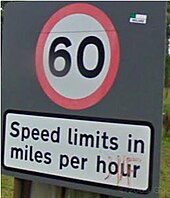

Road speed limits in the United Kingdom are used to define the maximum legal speed (which may be variable) for vehicles using public roads in the UK.
Speed limits are one of the measures available to attempt to control traffic speeds, reduce negative environmental effects of traffic, increase fuel use efficiency and satisfy local community wishes. The speed limit in each location is indicated on a nearby traffic sign or by the presence of street lighting.
Signs show speed limits in miles per hour (mph) or the national speed limit (NSL) sign may be used.
The national speed limit is 70 mph (113 km/h) on motorways, 70 mph (113 km/h) on dual carriageways, 60 mph (97 km/h) on single carriageways and generally 30 mph (48 km/h) (20 mph (32 km/h) in Wales) in areas with street lighting (Built-up area). These limits may be changed by road signs and apply to cars, motorcycles, car-derived vans up to 2 tonnes maximum laden weight (MLW), and to motorhomes or motor caravans not more than 3 long tons (3.05 tonnes) maximum unladen weight. Other classes of vehicles are subject to lower limits on some roads.[1]
Enforcement of UK road speed limits was traditionally done using police 'speed traps' set up and operated by the police who now increasingly use speed guns, automated in-vehicle systems and automated roadside traffic cameras. Some vehicle categories have various lower maximum limits enforced by speed limiters.
Ever since they have been introduced, speed limits have been controversial. They are both opposed or supported from various sources; including motoring advocacy groups, anti-motoring groups and others who either consider them to be irrelevant, set too low or set too high.
- ^ "Speed Limits". GOV.UK. UK Government. Retrieved 6 May 2015.
